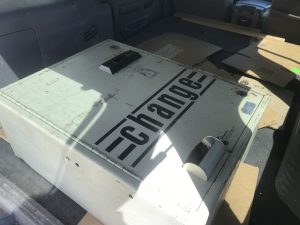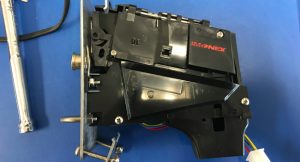One of my Speed Queen 40# washers had a main bearing start to make noise. we stopped using it and got on the phone to get some new parts on order and set up a repair.
This is not an easy repair and requires some special tool and techniques so you will probably want to call in an experienced Tech. There is also the issue that if there is a problem during or after the installation your machine isn’t down while you figure out what went wrong.
First I determined it was a bearing issue.
Next step was to order the new parts. It is possible to just change the bearings and seals and not the entire tub, shaft and trunnion but we could not determine if any changes or repairs had been done since installation. To check this we would have had to take it apart, measure the shaft diameter, order the bearings and seals and then once they arrived, install them.
This particular washer sits right inside the front door of the store and is the only one of this size. The impact it has on our customers and our own Drop Off service is a lot. We have to use 2 other washers while this is down which reduces the volume we can get through the store.
So the decision was made to spend the extra money and do it once. This also reduced the Service Tech time as there was only one trip.
I made sure I had the parts at the store before we confirmed the date of repair. There’s nothing like paying somebody to show up and wait for a delivery with you.

The day before the repair I decided to have the motor checked at a local repair shop to make sure it was OK. I have had a number of dryer motors rebuilt by them so they will usually test motors while I wait and have them repaired the same day. The benefits of using a smaller shop and paying right away.
It turns out the motor was fine so there was no charge. While your machine is down it’s a good time to check a few things and do some cleaning.
On the repair day, I helped the Tech with some of the work. He did the work on the back of the washer, the heavy and tough jobs, and I did the work on the front. See the Time Lapse Video below of the repair.
As the drum needs to come out form the front you need to remove the cover, door, door lock and switches and the clamp that holds the front part of the tub together.
I always take a picture of any of the electrical connections before I take anything apart. It’s faster then making a bunch of notes and saves my brain for other things.
You may not have to remove the wires. It will depend on how much the assembly swings out of the way.
The switches confirm the handle is shut and that the solenoid activated the door lock.

Once all the parts on the front and the back were removed the drum was pulled out from the front.

While the Tech worked on the trunnion and some other items I used the time to do some cleaning around the front of the machine.
One key point to clean is the level sensor tube. On this model it connects to the bottom of the tub in a small drain. As it is connected to a horizontal tube there is about 4″ that sit flat. This will have a tendency to get full of gunk . Spend the time to clean it out. This will make sure you have a good level in your washer and possibly reduce costs as a plugged line will add more water to the tub.
You can pull the tube off of the level sensor and flush it out in a sink. The stainless tube is a little more difficult to clean.

Now it was time to put everything back together.

The most difficult part on the front is getting the front piece of the drum and the clamp in place. It will take a few hands to hold it as you tighten it up. This needs to fit well to avoid leaks.
As I put the door back on I made a few adjustments so it would close nicely. It seems the washer didn’t like that so much and the drum rubbed on the door glass when it was spinning with a load. So the door was adjusted slightly to correct this issue.
Total time for the job was about 3 hours and we didn’t have any issues to deal with.
Let me know if you have any questions.
Ken




